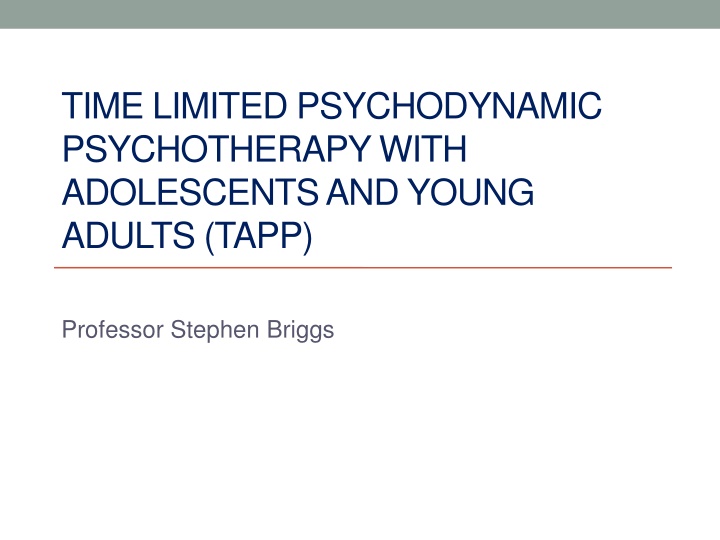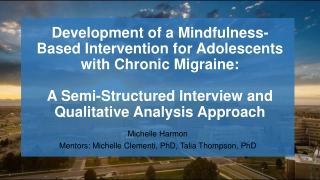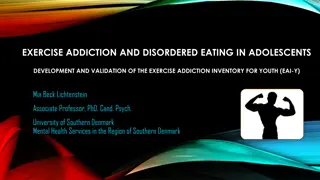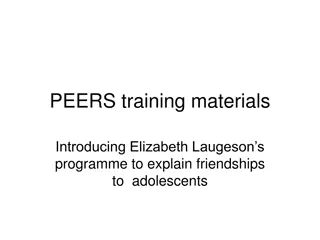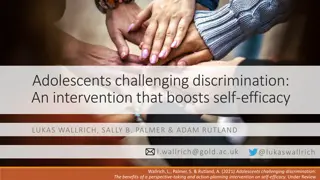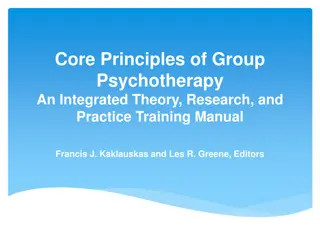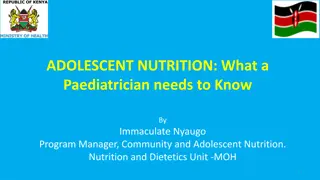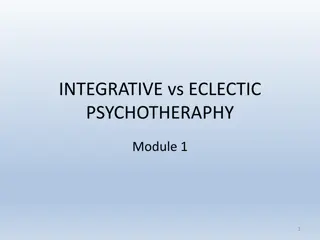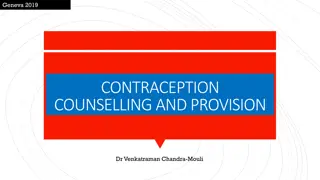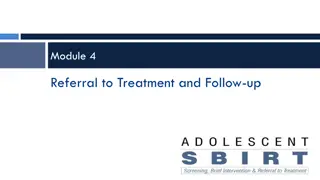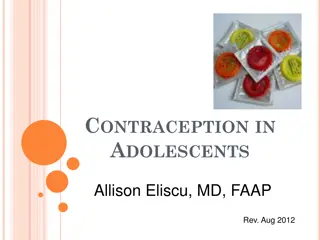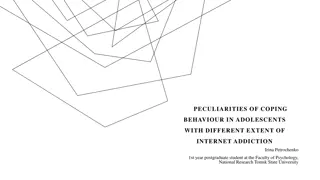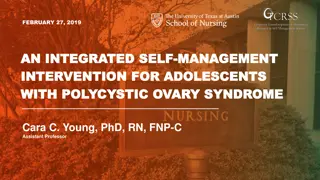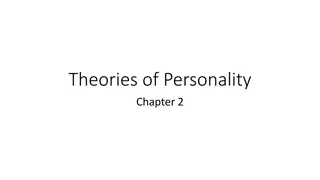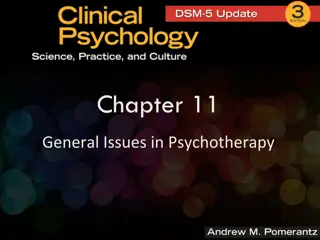Time-Limited Psychodynamic Psychotherapy for Adolescents
Specialized guide by Professor Stephen Briggs on effective psychodynamic therapy techniques for adolescents and young adults. Explore practical applications and insights for implementing Time-Limited Psychodynamic Psychotherapy (TAPP). Learn strategies for engaging and assisting young individuals in therapy sessions, enhancing their well-being and personal growth. Rich with theoretical perspectives and real-world examples, this resource offers valuable tools for mental health professionals working with this age group.
Download Presentation

Please find below an Image/Link to download the presentation.
The content on the website is provided AS IS for your information and personal use only. It may not be sold, licensed, or shared on other websites without obtaining consent from the author.If you encounter any issues during the download, it is possible that the publisher has removed the file from their server.
You are allowed to download the files provided on this website for personal or commercial use, subject to the condition that they are used lawfully. All files are the property of their respective owners.
The content on the website is provided AS IS for your information and personal use only. It may not be sold, licensed, or shared on other websites without obtaining consent from the author.
E N D
Presentation Transcript
TIME LIMITED PSYCHODYNAMIC PSYCHOTHERAPY WITH ADOLESCENTS AND YOUNG ADULTS (TAPP) Professor Stephen Briggs
SESSION 1: INTRO TO TAPP AND THE COURSE 10am- 10.30am
WHY DO WE NEED NEW THERAPEUTIC APPROACHES FOR YOUNG PEOPLE? 50% of all lifetime mental disorders begin before 14 and 70% by age 24 (MHG/DH 2011 page 50) Adolescent mental health is a major concern nationally and world-wide More intensive interventions in adolescence may reduce longer term problems (Patton et al 2014) There are very few evidenced psychological interventions for young people Adolescents need adolescent-centred approaches through therapies designed for their needs, and which they can buy into to increase engagement and good outcomes Adolescent problems are not neat diagnoses but complex psychosocial predicaments (Cottrell and Kroom 2005) in changing, diverse social contexts
Why do we need TAPP? TAPP was developed to meet the needs of young people who present at mental health services These young people present not with neat diagnoses but with predicaments Which often combine social vulnerability with mental health needs Thus, a psychosocial approach is helpful TAPP has been developed to: Respect the capacity for growth and development during adolescence Ensure young people s involvement through adolescent centred therapy Ensure relevance to young people s social and cultural contexts Provide a therapeutic modality which has a focus on emotions, relationships and relatedness
Where is TAPP being used? TAPP has been developed in CAMHS and in services specialising in adult mental health services for young people (e.g. Tavistock) Current applications include: CAMHS in England (e.g Leicester, Tower Hamlets, Kent) School counselling services HE counselling services Training to individuals and organisations to use TAPP TAPP has been manualised, and research to evidence its effectiveness is in preparation
What issues can be worked with using this model? The focus on development means TAPP can be considered for many young people. It is particularly useful for Complex presentations (social vulnerability plus m/h diagnoses) Difficulties in relationships (including e.g. (self)destructive relationships and self-harm/suicidal thoughts) Anxieties and difficulties around separation Anxieties around external events Depression Second treatments When there is an external time-limit When presentation is post-trauma Transitions from CAMHS to AMS
What is TAPP? TAPP s structure TAPP is a manualised time-limited psychodynamic therapy for young people between 14 and 25 (30) It has a usual structure of 4 sessions assessment followed by 16 sessions treatment, with a follow up-review session 6-8 weeks after the end of treatment TAPP s rationale The developmental process in adolescence is a powerful force for change and growth Therapeutic focus on developmental difficulty/disturbance can recover the individual s capacity to meet her/his developmental challenges Therapeutic structures of time and focus can help young people manage development and transitions in their social and cultural contexts
Key features of TAPP TAPP is based on Psychoanalytic approaches to understanding and conceptualising adolescent development Psychodynamic approach to therapeutic relatedness including focus on the transference and counter transference working in depth It is adolescent centred notably through active engagement of young people in establishing the focus for therapy, contracting processes and working with their narratives of themselves It is rooted in understanding the young person s negotiation of their transitions through adolescence within their social and cultural contexts Time-limits provide a structure for working with processes of engagement, relating, change, ending, and reviewing
The therapists priorities when using TAPP Working with a developmental focus Working in depth, particularly with the transference and counter-transference, and thus accessing deep anxieties Adopting a stance that provides a containing therapeutic space and which is thus both supportive and promoting possibilities for exploration Support for the therapist is through supervision/seminar group, focussing on the meaning of the therapist s emotional experiences Working with time-limits
The values and challenges of the time- limited approach: pros and cons? In favour of time-limit Against time-limit Provide structure in complex and confusing socio-cultural transitional contexts for young people or feel like an oppressive imposition on freedom .or make it difficult to work through more problematic/pathological aspects of development Provide a focussed intervention or put therapists under pressure to work within a timescale Help therapists through structuring therapy
Exercise In Pairs Share thoughts about working with young people Complete the questionnaire and use this to discuss: The kinds of issues that young people have and that you work with in your work setting Issues that arise for you in working with them Sharing the examples of your work you have reflected on before the course and/or Examples of your work that you are thinking about now Thoughts about your hopes and expectations for the course Followed by feedback to whole group
SESSION 2: UNDERPINNING PRINCIPLES OF TAPP 11.00 - 11.30am 11.45- 12.45
Development, change and growth in psychodynamic therapies What are the key concepts in psychodynamic practice? Past relatedness and experiences affect the present We defend against experiences that make us anxious Past aspects of relatedness are attributed to others in the present (transference) These are received by the other as emotional experiences which if recognised can help understanding (of the client) Therapy aims to increase self- understanding and the capacity to sustain (rather than discharge) emotions
Psychodynamic therapeutic action Recovering past memories and patterns of relatedness Working through in the transference Containment of anxieties to increase the capacity to think about feelings rather than discharging them Healing power of the narrative Integrating accounts from the past to achieve narrative coherence and authenticity The corrective emotional experience Making implicit relational models explicit Mutative exchanges A.Lemma (2003) Introduction to the Practice of Psychoanalytic Psychotherapy (page 82)
The process of container-contained Infant projects overwhelming feelings Infant takes in named experiences and mother s thinking capacity Mother takes in infant s feelings, makes sense of them Mother returns feelings, named, in modified form
Internalisation in infancy Qualities of internalisation depend on qualities in the container- contained relationship (Bion 1962) Infant s overwhelming experiences are projected into the mother Mother s reverie makes sense of infant s emotional experiences Infant s anxieties are modified, named, made bearable Infant internalises named emotional experiences and a mother who can bear to think about emotions and modify anxieties Internalisation when infants are in vulnerable situations: intense anxieties may not be mediated and will overwhelm the infant the infant defends against painful experiences the infant s internalisations will include internal relatedness in which dependency, intimacy and capacity to be separate will be disturbed
Contemporary Adolescence Contemporary adolescence is organised around two distinct phases. The transition from childhood to early adolescence, through the impact of puberty, is a period of intense growth and far reaching changes- physically, cognitively, emotionally. This is followed by a long transition into adulthood, which, though inclusive of diverse pathways is usually extended, lasting approximately for a decade from mid/late teens until the mid twenties.
Becoming-a-Subject During adolescence, the young person moves from being a child in the family to being a person in the world To accomplish this, the adolescent has to achieve: Separation from parental figures Ownership of new, adult, sexual body and its role in the social world Ownership of capacity for thought; thinking one s own thoughts, separate from others Ownership of drives, sensations, impulses, feelings and powers Problems in adolescence stem from problems in the adolescent developmental process in becoming a subject
The entanglements of early adolescence the extraordinary entanglement, in the young adolescent s world, of internal and external, and of bodily and mental forces and factors (Waddell 2002) The aim with early adolescence is to get past it and then not look back! (Jacobs 1990) though he was growing it was not a problem for him, but he had two friends who did have problems, because for one of them his bones were growing faster than his muscles and ligaments, and with the other friend it was the other way round; his muscles were growing faster than his bones. One of them was very stiff and the other was very floppy.
The adolescent process it cannot be hurried, but it can be undermined The cure for adolescence belongs to the passage of time and to the gradual maturational processes; this process cannot be hurried or slowed up but it can be broken into and destroyed, or it can wither up from within (Winnicott 1971)
The power of the adolescent body Leaving the quiescence of latency, acquiring adult (physical) power: In latency It is the very balance of a relatively weak child and relatively strong parents which, whatever the impulses and anxieties is a background bedrock of reality which allows for a sense of safety. (Anderson 1999) In adolescence, with the acquisition of the adult sexual body S/he can really attack, destroy, rob, murder or commit suicide, and he can really have sexual experiences of a or homosexual kind (Hoxter 1964 page 13).
Adolescence: a second chance (Blos) Dickie Bird (1989): assessing adolescents involves the question of identifying to whom pain and anxiety belong and are attributed (projective processes). A H Williams (1978) explored the dynamic meaning of depression in adolescence as a force for development as well as a painful situation R. Anderson and A. Dartington (1998) If the adolescent is to successfully achieve adulthood, he (sic) must re-negotiate every aspect of his relationship with himself, and with his external and internal objects in a new context Margot Waddell (2002) the extraordinary entanglement, in the adolescent s world, of internal and external, and of bodily and mental forces and factors and (2006) the swiftness with which what seem to be deeply entrenched narcissistic structures may be modified or modulated in response to even quite small internal or external change
The developmental process Development is formulated as the working through of the dynamic effects of puberty for the individual, necessitating reworking of relatedness to self and others It is significantly affected by the qualities of close relationships with parents, authority figures outside the family, peers, emerging love relationships, and those of social and cultural contexts It requires: establishing the integration of the adult sexual body as essential to individual identity, the ownership of one s own thoughts, drives, sensations, impulses, feelings and powers accepting the emotional experience and meaning of increasing emotional, mental and/or physical separateness from parental figures as experienced in diverse social and cultural contexts
Catastrophic change Development in adolescence and early adulthood generates catastrophic change (Bion 1963) through the disjuncture of past, present and future. It involves intense emotional experiences which disturb previous qualities and patterns of containment, ways of defending against anxiety that worked in childhood, it puts pressure on the individual to manage and make sense of emotional experiences. This leads to new defences against anxiety, including splitting, projection, denial, idealization, projective identification. Development is therefore characterised by powerful progressive and regressive trends and involves rapid shifts of states of mind, moving between paranoid schizoid and depressive functioning (Ps<->D)
Development in current contexts Developing subjectivity in particular domains of experience more accurately describes these changes than does the more traditional concept of identity formation (2011 p418) Pathways into adulthood have become more complex, extended, less structured, desequenced , disembedded These create a deeply contradictory situation and generate new and different psychological tasks thinking flexibly about future plans, making decisions, responding to changing contexts, generating narratives to make sense of these experiences Fast-track and slow-track routes
Inequalities increasing: Fast Track and Slow Track transitions Slow track Fast track Leaving education on or before min. age Risks of unemployment, poor wages NEET Early family formation Higher anti-social behaviour rates Social exclusion (Early achievement of adulthood more likely to mean premature loss of childhood) Lack of social capital Staying on in education (until 30 or later) Many semi-independent statuses requiring parental support Problematic for those without middle class models of parental support Can result in broken or fractured transitions Mental health issues arise Acquiring social capital
Becoming a subject in adolescence Separation- Individuation Self-esteem/ competence Fear of failure States of mind Subject to Subject of Power Dependence Death Life Regression
SESSION 3: ASSESSING FOR TAPP 1.45-3.00
Working with First young person adolescents is Therapist: the plan is different! that we will meet weekly for 16 weeks Questions of Young person1 : Really? time, balance . As long as that? Am I and ambiguity really that ill then? Third young person Second young person Therapist: the plan is Therapist: the plan is that we will meet weekly that we will meet weekly for 16 weeks for 16 weeks Young person 3: It s Young person 2: Oh no down to you is it what if what will I do after that? I don t agree? It s my life
The psychodynamic pyramid/prism (for adolescence) Development Past Relationships Current relationships Transference
The Assessment The offer of therapy is primarily a process which requires discussion, negotiation and containment of the emotional experiences involved .the therapist suggests discussing together the kind of treatment that will be most helpful and appropriate and seeks the active involvement of the young person in this process
Assessment is usually four weekly interviews Engaging young person in weekly sessions Establishing modes of learning/relating (including attributions of pain/anxiety Bird 1989) (e.g. thinking between sessions) Making a treatment offer in 3rd session, including articulation of the developmental focus Offer reviewed, and contracted in 4th session
SESSION 4: FORMULATING: MAKING A TREATMENT OFFER: THE DEVELOPMENTAL FOCUS 3.15-.4.30
Formulations includes a focus on the qualities of change that occur during the assessment contrasting more free flowing, discovery-laden interactions with those that are more stuck, rigid or repetitive. Through this process, the therapist arrives at a view of the developmental trajectories of the young person, the anxieties and defences he has, and the qualities of internalisation/inner object relations that support or disturb the process of development. These are characteristically experienced in relation to the therapist; emergent patterns of transference counter-transference are elucidated initially provisionally
The treatment offer An offer of TAPP is usually made during the third assessment session, and this is discussed and negotiated in the fourth session the offer of 16 sessions treatment (plus a review session after the therapy), which can be stated as therapy continuing up to a specified time, e.g. the end of a specific month, or in relation to an acknowledged future event in the YP s life the formulation of the purpose of the brief therapy in terms of a developmentally based focus e.g. working to understand more how these problems affect you whilst you are changing and growing or getting to grips with how (a particular event, a current set of relationships, a current task) these affect you as you go through a period of development and change or An agreement of a suitable regular time for the therapy
The Young Persons response The offer is primarily a process which requires discussion, negotiation and containment of the emotional experiences involved. Initially, either in the first or second session, the therapist suggests discussing together the kind of treatment that will be most helpful and appropriate and seeks the active involvement of the young person in this process. The young person may respond with a thoughtful response which creates the opportunity of a genuine negotiation, or, alternatively, by omnipotent assertion, eager acceptance which needs no discussion or pre-empts it, or passive deference to the therapist s authority and knowledge. At this point some ambivalences frequently emerge and can be expressed in terms of contradictory wishes for treatment e.g. the young person says he wishes for weekly therapy but does not have the availability to attend regularly or wishing for something that will not involve effort and work, an instant prescription which can be taken away and ingested.
The developmental focus Theorisation of the developmental process in adolescence underpins the formulations of a developmental focus for each case: The presence of anti-developmental factors that reduce the capacity to engage with current life tasks and relationships, and/or The absence or weaknesses of resources that can promote growth and development The developmental focus relates closely to the young person s own account of themselves and their struggles and anxieties, and to encompass a sense of becoming, of encouraging curiosity about self and others.
REVIEW OF THE DAY 4.30-5.00
one of the outcomes of TAPP is the young person s engagement with the continuous project of themselves, the development of their subjectivity, and awareness of their emotionality (2011 p423)
TAPP training courses Practitioner TAPP training consists of 3 elements: 2 day introductory (this can be taken as stand alone e.g. for CPD) Supervision of TAPP cases 3 one day workshops Accreditation as a TAPP practitioner additionally involves assessments The training is in process of accreditation by the British Psychoanalytic Council (BPC)
Contact and further information Stephen Briggs stephenbriggs04@gmail.com s.briggs@uel.ac.uk www.stephenbriggsconsulting.co.uk Please contact me for further information including Copy of the manual for TAPP Training and supervision in TAPP Research of the application of TAPP Service consultation for introducing and using TAPP
